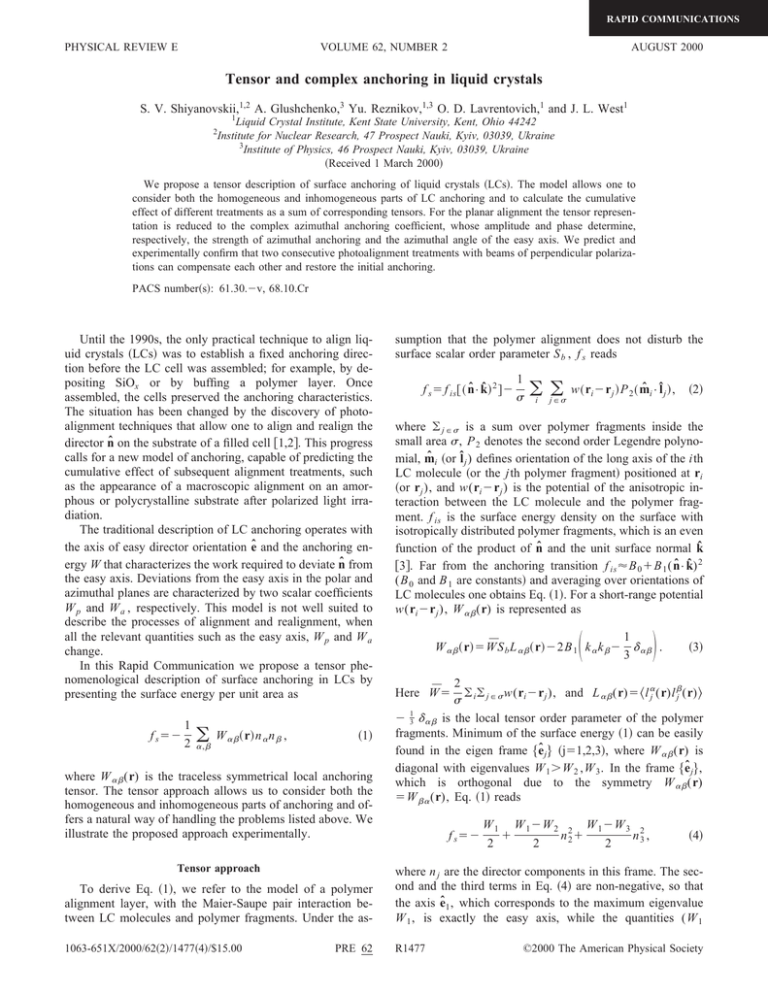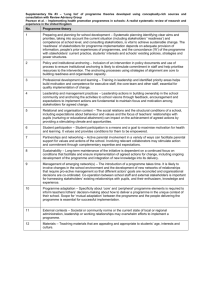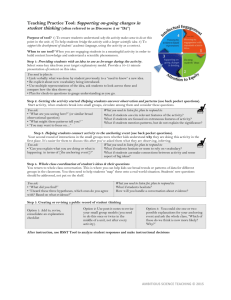Tensor and complex anchoring in liquid crystals
advertisement

RAPID COMMUNICATIONS PHYSICAL REVIEW E VOLUME 62, NUMBER 2 AUGUST 2000 Tensor and complex anchoring in liquid crystals S. V. Shiyanovskii,1,2 A. Glushchenko,3 Yu. Reznikov,1,3 O. D. Lavrentovich,1 and J. L. West1 1 Liquid Crystal Institute, Kent State University, Kent, Ohio 44242 Institute for Nuclear Research, 47 Prospect Nauki, Kyiv, 03039, Ukraine 3 Institute of Physics, 46 Prospect Nauki, Kyiv, 03039, Ukraine 共Received 1 March 2000兲 2 We propose a tensor description of surface anchoring of liquid crystals 共LCs兲. The model allows one to consider both the homogeneous and inhomogeneous parts of LC anchoring and to calculate the cumulative effect of different treatments as a sum of corresponding tensors. For the planar alignment the tensor representation is reduced to the complex azimuthal anchoring coefficient, whose amplitude and phase determine, respectively, the strength of azimuthal anchoring and the azimuthal angle of the easy axis. We predict and experimentally confirm that two consecutive photoalignment treatments with beams of perpendicular polarizations can compensate each other and restore the initial anchoring. PACS number共s兲: 61.30.⫺v, 68.10.Cr Until the 1990s, the only practical technique to align liquid crystals 共LCs兲 was to establish a fixed anchoring direction before the LC cell was assembled; for example, by depositing SiOx or by buffing a polymer layer. Once assembled, the cells preserved the anchoring characteristics. The situation has been changed by the discovery of photoalignment techniques that allow one to align and realign the director n̂ on the substrate of a filled cell 关1,2兴. This progress calls for a new model of anchoring, capable of predicting the cumulative effect of subsequent alignment treatments, such as the appearance of a macroscopic alignment on an amorphous or polycrystalline substrate after polarized light irradiation. The traditional description of LC anchoring operates with the axis of easy director orientation ê and the anchoring energy W that characterizes the work required to deviate n̂ from the easy axis. Deviations from the easy axis in the polar and azimuthal planes are characterized by two scalar coefficients W p and W a , respectively. This model is not well suited to describe the processes of alignment and realignment, when all the relevant quantities such as the easy axis, W p and W a change. In this Rapid Communication we propose a tensor phenomenological description of surface anchoring in LCs by presenting the surface energy per unit area as f s ⫽⫺ 1 2 W ␣ 共 r兲 n ␣ n  , 兺 ␣, 共1兲 where W ␣ (r) is the traceless symmetrical local anchoring tensor. The tensor approach allows us to consider both the homogeneous and inhomogeneous parts of anchoring and offers a natural way of handling the problems listed above. We illustrate the proposed approach experimentally. Tensor approach To derive Eq. 共1兲, we refer to the model of a polymer alignment layer, with the Maier-Saupe pair interaction between LC molecules and polymer fragments. Under the as1063-651X/2000/62共2兲/1477共4兲/$15.00 PRE 62 sumption that the polymer alignment does not disturb the surface scalar order parameter S b , f s reads f s ⫽ f is 关共 n̂•k̂兲 2 兴 ⫺ 1 兺i j苸兺 w 共 ri ⫺rj 兲 P 2共 m̂i • l̂ j 兲 , 共2兲 where 兺 j苸 is a sum over polymer fragments inside the small area , P 2 denotes the second order Legendre polynomial, m̂i 共or l̂ j ) defines orientation of the long axis of the ith LC molecule 共or the jth polymer fragment兲 positioned at ri 共or r j ), and w(ri ⫺r j ) is the potential of the anisotropic interaction between the LC molecule and the polymer fragment. f is is the surface energy density on the surface with isotropically distributed polymer fragments, which is an even function of the product of n̂ and the unit surface normal k̂ 关3兴. Far from the anchoring transition f is ⬇B 0 ⫹B 1 (n̂•k̂) 2 (B 0 and B 1 are constants兲 and averaging over orientations of LC molecules one obtains Eq. 共1兲. For a short-range potential w(ri ⫺r j ), W ␣ (r) is represented as 冉 冊 1 W ␣ 共 r兲 ⫽W̄S b L ␣ 共 r兲 ⫺2B 1 k ␣ k  ⫺ ␦ ␣ . 3 共3兲 2 兺兺 w(ri ⫺r j ), and L ␣ (r)⫽ 具 l ␣j (r)l j (r) 典 i j苸 ⫺ 13 ␦ ␣ is the local tensor order parameter of the polymer fragments. Minimum of the surface energy 共1兲 can be easily found in the eigen frame 兵 ê j 其 共j⫽1,2,3兲, where W ␣ (r) is diagonal with eigenvalues W 1 ⬎W 2 ,W 3 . In the frame 兵 ê j 其 , which is orthogonal due to the symmetry W ␣ (r) ⫽W ␣ (r), Eq. 共1兲 reads Here W̄⫽ f s ⫽⫺ W 1 W 1 ⫺W 2 2 W 1 ⫺W 3 2 ⫹ n 2⫹ n3 , 2 2 2 共4兲 where n j are the director components in this frame. The second and the third terms in Eq. 共4兲 are non-negative, so that the axis ê1 , which corresponds to the maximum eigenvalue W 1 , is exactly the easy axis, while the quantities (W 1 R1477 ©2000 The American Physical Society RAPID COMMUNICATIONS R1478 S. V. SHIYANOVSKII et al. ⫺W2) and (W 1 ⫺W 3 ) determine the traditional azimuthal and polar anchoring coefficients. A comparison of Eq. 共1兲 and Eq. 共4兲 shows the difference between the tensor and the traditional approaches. The traditional description is equivalent to the tensor one in the eigenframe 兵 ê j 其 . This frame rotates from point to point and during a treatment, making the description cumbersome. The tensor description has the covariant form and thus describes random anchoring and consecutive treatments in any reference frame. One has to distinguish the local W ␣ (r) and its macroscopic average over the whole surface 具 W ␣ (r) 典 r . An untreated inhomogeneous substrate has macroscopic azimuthal symmetry, therefore, the average polymer tensor order pain (r) 典 r should be diagonal in the 0xyz frame rameter 具 L ␣ in (0z 储 k̂) with diagonal elements 具 L xx (r) 典 r⫽ 具 L in y y (r) 典 r⫽L 兩兩 in and 具 L zz (r) 典 r⫽L⬜ . According to Eq. 共3兲, the average anin choring tensor 具 W ␣ (r) 典 r should have the same form in in in (r) 典 r⫽W⬜ . Since the 具 W xx (r) 典 r⫽ 具 W y y (r) 典 r⫽W 兩兩 and 具 W zz two diagonal elements are equal, orientation of the easy axis is degenerate 共the only exception is strictly normal orientain (r) from tion兲. Therefore, even a small deviation of W ␣ in 具 W ␣ (r) 典 r , caused by local inhomogeneities in orientation of aligning fragments, lifts the degeneracy and sets a unique orientation of the local easy axis. Photoalignment on polymer surface leads to additional orientational ordering of the aligning fragments. If the initial in (r) local variations of the polymer order are small, 兩 L ␣ in k ⫺ 具 L ␣ (r) 典 r兩 Ⰶ1, the additional order L ␣ (r), caused by the kth uniform treatment, does not depend on these variations k k k and is also uniform: L ␣ (r)⫽ 具 L ␣ (r) 典 r⫽L ␣ . Thus, the ‘‘weak’’ treatments, which affect only a small fraction of the polymer fragments, lead to the final anchoring tensor W that is simply a sum of the random initial anchoring Win and the contributions W(k) of different treatments: W共 r兲 ⫽Win 共 r兲 ⫹ 兺k W(k) , 共5兲 where W(k) is diagonal in the frame which corresponds to the induced easy axis ê(k) . The effect of ‘‘strong’’ treatments, which reorient a substantial fraction of the polymer fragments, can also be expressed with Eq. 共5兲, but in this case W(k) are nonlinear functions of the irradiation times k and the sequence of the different treatments is crucial. It should be noted that Eq. 共5兲 is not suitable to describe photoalignment on dynamically equilibrium substrates 共such as Langmuir-Blodgett films兲. In this case photoinduced reorientation of entire domains was observed and was described by the macroscopic model 关4兴. Complex representation for planar anchoring Substantial simplification can be achieved for the tangential 共in-plane兲 alignment that corresponds to W yz ⫽W xz ⫽0. It is useful to specify the director on a complex plane: ñ ⫽n x ⫹in y ⫽cos ei, where is a polar angle and is the azimuthal angle. The surface energy 共1兲 takes the form PRE 62 FIG. 1. Graphic representation of the complex anchorings 关Eq. 共7兲兴. 共a兲 The cumulative effect of two homogeneous treatments with different induced easy axes: ê(1) 储 0x and ê(2) making the angle 2 with 0x axis; dashed curve shows the trajectory of the vector Wa ⫽W a ê when W (2) increases. 共b兲 The effect of the unidirectional a homogeneous treatment W̃ 1a 共thick arrow兲 at different points of an inhomogeneous substrate with local anchorings W̃ in a (r) 共thin arrows兲; W̃ a (r) 共dashed arrows兲 are the resulting anchorings at the same points of the surface. 1 3 f s ⫽ f s0 ⫺ 共 W̃ a* ññ⫹W̃ a ñ * ñ * 兲 ⫹ W zz ññ * 8 4 1 1 ⬘ ⫹ W a cos2 sin2 共 ⫺ 兲 ⫹ W p sin2 , ⫽ f s0 2 2 共6兲 ⬘ are insignificant constants, which may be where f s0 and f s0 dropped, W̃ a ⫽W xx ⫺W y y ⫹2iW xy ⫽W a e i2 is the complex azimuthal anchoring coefficient, and W p ⫽ 21 (W a ⫺3W zz ). The complex representation has the following advantages: 共1兲 W p , W a , and in Eq. 共6兲 and in the definition W̃ a ⫽W a e i2 are simply the traditional anchoring coefficients and the azimuthal angle of the easy axis, respectively. 共2兲 W a is the linear combination of tensor components, thus the complex representation preserves the additivity of different treatments: W̃ a 共 r兲 ⫽W̃ in a 共 r兲 ⫹ 兺k W̃ (k) a . 共7兲 共3兲 Any treatment is presented in a compact form W̃ (k) a ⫽W (k) a exp(2ik), where the phase describes the orientation k of the induced easy axis and the amplitude W (k) a corresponds to the strength of the treatment. One can visualize different surface treatments graphically presenting W̃ (k) a by vectors in the complex plane; see Fig. 1. We illustrate the complex representation by the following examples. A substrate with a uniform in-plane easy axis is irradiated with polarized light that produces a different easy axis. According to Eq. 共7兲 the resulting complex anchoring (1) W̃ a is the sum of the initial anchoring W̃ (1) a ⫽W a exp(2i1) (2) and light-induced anchoring W̃ (2) a ⫽W a exp(2i2). The am(2) plitude W a is controlled by the exposure. When the initial and the light-favored easy axes are not perpendicular, the RAPID COMMUNICATIONS PRE 62 TENSOR AND COMPLEX ANCHORING IN LIQUID CRYSTALS R1479 FIG. 2. The textures of the same spot 共about 250 m wide兲 before irradiation 共a兲, after the first irradiation with ê(1) u v ⬜êrub , 1 储 ⫽15 s 共b兲, and after the second irradiation with ê(2) ê rub , 2 ⫽45 s uv 共c兲. Parallel polarizers. increase of W (2) a leads to a continuous rotation of the easy axis ê from 1 to either 2 or to 2 ⫹ , whichever is closer to 1 关dashed curve, Fig. 1共a兲兴. When the two are perpendicular, 2 ⫽ 1 ⫹ /2, the dashed curve collapses into the right angle and there is no continuous reorientation. In this (1) case, when the treatment is weak, W (2) a ⬍W a , the resulting easy axis does not move, but the anchoring strength de(1) creases, W a →0. When W (2) a ⬎W a , the easy axis abruptly realigns from 1 to 2 ⫽ 1 ⫹ /2. Both the smooth rotation 关5兴 and the threshold realignment 关6兴 have already been observed. In a similar way, Eq. 共7兲 describes changes when an inhomogeneous substrate is subjected to a uniform alignment treatment W̃ (1) a 关Fig. 1共b兲兴. This treatment ‘‘hides’’ the random anchoring rather than destroys it; the resulting W̃ a (r) is in the vector sum of W̃ (1) a and the local W̃ a (r). This feature predicts an interesting and counterintuitive effect: the original random anchoring modified by the unidirectional treat- FIG. 4. The transmittance anisotropy vs irradiation time. Curve A corresponds to the first irradiation with ê(1) u v ⬜êrub . Curves B and C result from the second irradiation with ê(2) u v 储 êrub that follows the first irradiation of duration 1 ⫽15 s and 1 ⫽60 s, respectively. ment W̃ (1) a can be restored by a subsequent treatment of the (1) same amplitude W (2) a ⫽W a but of the orthogonal direction (1) 2 ⫽ 1 ⫹ /2, i.e., W̃ (2) a ⫽⫺W̃ a . The validity of the tensor and complex description and in particular, the compensating (1) effect of two treatments, W̃ (2) a ⫽⫺W̃ a , is demonstrated experimentally below. Experiment We studied the nematic LC 4,4’-n-pentylcyanobiphenyl 共5CB, Merck兲 and the photoaligning polymer para-fluorocinnamoyl cellulose 共FCCN兲. 5CB is placed between the reference and the FCCN substrates. The nonirradiated surface of FCCN aligns 5CB tangentially. The reference substrate is a rubbed polyimide layer that produces strong planar anchoring along the rubbing direction êrub . The cell thickness was chosen to be large, L⫽55 m, to reduce the elastic torque ⬃K 22 /L caused by the fact that êrub is generally not parallel to the local easy axis of FCCN substrate. Here K 22 is the twist elastic constant. Inhomogeneous anchoring at the nontreated FCCN substrate FIG. 3. Light transmittance of the cell vs the orientation of the analyzer for the nonirradiated (䊏) and the irradiated (䉱) 1 ⫽60 s cell. The cell was filled with 5CB in the isotropic state (100 °C). The FCCN substrate was put in contact with a cooled surface to create a temperature gradient across the cell. The nematic phase nucleated at the FCCN surface first, and then propagated towards the reference plate. In this way, alignment of LC at FCCN was determined mainly by the anchoring properties of the FCCN surface. The alignment is inhomogeneous with characteristic size of domains d ⬃100 m; see Fig. 2共a兲. The reference rubbed surface faced the polarizer of the microscope, with êrub being parallel to the polarizer. The polarization of the transmitted light is determined by the local director orientation on the FCCN substrate 共‘‘Mauguin regime’’兲. The total intensity of the transmitted light did not depend on the orientation of the analyzer within an error of 10%; see Fig. 3. Thus, the local at the FCCN surface is random azimuthal anchoring W FCCN a and strong enough to withstand the orienting action of the RAPID COMMUNICATIONS R1480 S. V. SHIYANOVSKII et al. PRE 62 Compensating effect of two orthogonal irradiations 90°-twist structure in the cell 关Fig. 2共b兲兴. The bright lines in Fig. 2共b兲 correspond to domain walls that separate regions (1) with opposite rotations. The second treatment with ê(2) u v ⬜êu v 共Fig. 4, curve B) exhibits the mirror behavior in comparison with curve A with respect to the value of between the irradiations. The texture obtained after 2 ⫽45 s when returns to its initial value ( ⫽0), Fig. 2共c兲, is essentially identical to the initial texture, Fig. 2共a兲, i.e., the second exposure recovers the initial pattern n̂(r) in details. If 1 ⬎15 s the recovery of ( ⫽0) is not achievable, although ( ) clearly preserves the mirror behavior 共Fig. 4, curve C). The recovery of the initial texture in the saturation range for the second treatment confirms the validity of Eqs. 共5兲 and 共7兲, even for strong treatments. Note in conclusion that the proposed tensor description is also a powerful tool to study the statistical properties of surface anchoring 共e.g., the correlation length for easy axis, the average domain size, etc.兲 using the correlator G ␣ , ␥ (r⬘ ) ⫽ 具 W ␣ (r)W ␥ (r⫹r⬘ ) 典 r . To demonstrate the recovery of the initial inhomogeneous anchoring, the cell with nontreated substrate 关Fig. 2共a兲兴 was subjected to two subsequent uv orthogonal treatments. The first treatment with ê(1) u v ⬜êrub during 1 ⫽15 s induced a The authors are grateful to Igor Gerus for the synthesis of FCCN. The work was supported by the NSF STC ALCOM, Grant No. DMR89-20147 and by the Fund of the Academy of Sciences of Ukraine, Grant No. B29/13. 关1兴 K. Ichimura, in Photochemical Processes in Organized Molecular Systems, edited by K. Honda 共Elsevier, Amsterdam, 1991兲, p. 343. 关2兴 T. Marusii and Yu. Reznikov, Mol. Mater. 3, 1614 共1993兲. 关3兴 T.J. Sluckin and A. Poniewierski, in Fluid Interfacial Phenomena, edited by C.A. Croxton 共Wiley, New York, 1985兲, p. 215. 关4兴 S.P. Palto, S.G. Yudin, C. Germain, and G. Durand, J. Phys. II 5, 133 共1995兲 S.P. Palto and G. Durand, ibid. 5, 963 共1995兲. 关5兴 J. Chen, D.L. Johnson, P.J. Bos, X. Wang, and J.L. West, Phys. Rev. E 54, 1599 共1996兲; J.H. Kim, S. Kumar, and SinDoo Lee, ibid. 57, 5644 共1998兲. 关6兴 A.G. Dyadyusha, T.Ya. Marusii, V.Yu. Reshetnyak, Yu.A. Reznikov, and A.I. Khizhnyak, Pis’ma Zh. Eksp. Teor. Fiz. 56, 18 共1992兲 关JETP Lett. 56, 17 共1992兲兴. 关7兴 O.D. Lavrentovich and P. Palffy-Muhoray, Liq. Cryst. Today 5 共2兲, 5 共1995兲. 关8兴 J.-B. Fournier and P. Galatola, Phys. Rev. Lett. 82, 4859 共1999兲. reference rubbed substrate, W FCCN ⰇK 22 /L, and the increase a of elastic energy, caused by inhomogeneities W FCCN ⰇK/d a 关7,8兴, where K is one of the elastic constants. Alignment by polarized light The cell described above was exposed to polarized uv light 共Hg lamp, intensity 5 mW/cm2 ) that is absorbed effectively by FCCN. The induced alignment direction êu v is perpendicular to the polarization of the incident light, Eu v . Irradiation reorients n̂ towards êu v and produces macroscopic optical anisotropy of the cell; see Fig. 3. To quantify the anisotropy we use the parameter ⫽(I 兩兩 ⫺I⬜ )/(I 兩兩 ⫹I⬜ ), where I 兩兩 and I⬜ are the intensities of transmitted light measured with analyzer parallel and perpendicular to êu v , respectively. The dependence of on the exposure time 共Fig. 4, curve A) corresponds to the scenario depicted in Fig. 1共b兲 and reveals the nonlinear effect with saturation.



